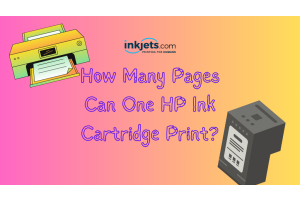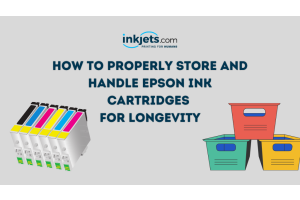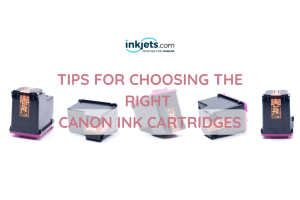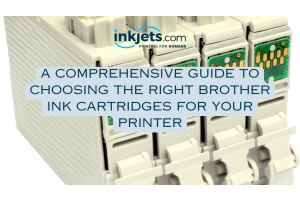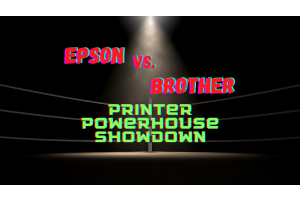
If you have ever purchased a printer, you are likely aware of how difficult
it can be to comprehend the subtleties of the various ink cartridges.
In this article, we answer all of your concerns about Canon ink specifically,
including what types of cartridges Canon sells, which cartridges
will save you the most money, and basic troubleshooting
techniques, so that you can become an ink expert!
The types of Canon ink cartridges
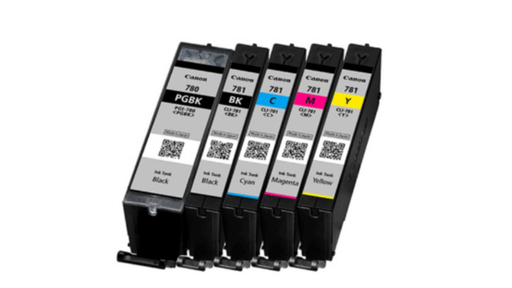
Canon mainly sells two types of ink cartridges.
Some Canon printers utilize a black and tri-color cartridge,
and some use individual ink cartridges.
Both types of cartridges produce the same high-quality prints
that consumers have come to expect from Canon,
but many users choose individual ink cartridges
because they offer greater flexibility and greater
long-term savings.
Tri-Color and Black Ink Cartridges
The majority of Canon printers with black and tricolor cartridges are affordable.
Because they feature a built-in printhead, these cartridges are also known as
integrated printer cartridges.
If you print frequently, you will likely pay more on replacing ink
than on the printer itself. The black cartridge utilizes
exclusively black ink and the tri-color cartridge
has three distinct chambers that are loaded with cyan,
magenta and yellow ink.
Canon produces popular black and tricolor cartridge packs.
PG-240 / CL-241 black, PG-245 / CL-246 black,
PG-260 / CL-261 black, and
PG-275 / CL-276 color.
The greatest complaint regarding these cartridges is the inefficiency
of the tri-color cartridge: when one of the colors begins to run low,
you must replace the complete cartridge in order to continue printing.
This means that if you do a lot of color printing,
replacement expenses will pile up quickly.
A Canon printer that employs individual ink cartridges is a better option
for most since each color cartridge may be replaced as needed.
Compared to individual ink cartridges or the MegaTank ink bottles
discussed later in this article, black and tri-color cartridges
are also the least ink-efficient, resulting in a higher
cost per page.
Individual Canon ink cartridges
Typically, individual ink cartridges are packaged in sets of four:
black, cyan, magenta, and yellow.
Certain Canon picture printers that produce more colorful prints
require additional colors, such as an extra black cartridge
for photo printing, however the majority of printer owners
will find that their machine only uses four cartridges.
Individual ink cartridge printers are a wise investment because
each cartridge may be replaced as needed.
Hence, if you are running low on cyan, you can continue printing
by simply replacing that color.
Several customers question whether or not all cartridges must be fitted
in order to print. The response is YES. If a printer cartridge is missing,
the printer will not function.
Individual ink cartridges lack an integrated printhead, unlike the black
and tricolor cartridges described above.
Instead, they rely on the printhead within the printer to aid in the
printing process. Both printhead kinds are equally effective.
Notably, if you purchase a printer with an integrated printhead,
it may wear down with time, and replacing it can be costly.
In fact, most individuals would rather purchase a new printer
than replace the printhead, as the printer is typically
less expensive.
To get the most out of your printer and to extend the life of your ink,
we suggest running the printhead cleaning feature every few weeks.
This prevents your cartridges from drying out between print jobs
by keeping them primed.
What sizes of cartridges can you buy?
Canon sells the majority of their cartridges in two yield sizes: normal and XL.
Certain printers utilize XXL, or extra-high yield, cartridges.
All three cartridge sizes are the exact same size and install in your printer
the same way, the only variable is the amount of ink that is inside the
cartridge.
The high yield cartridges are slightly more expensive but often a better long-term
value than the regular yield when you compare the cost per page.
At Inkjets.com, the majority of our compatible cartridges have a high yield,
allowing you to print longer for less money.
To illustrate, we will compare the page yield and cost of the Canon PG-280
line of ink cartridges.
These series of Canon printers are compatible with Canon PG-280 standard yield,
280XL high yield, and 280XL extreme high yield ink cartridges.
It makes sense for frequent printer users to pay more for a cartridge
with a higher yield because they give a better overall value.
If you only print sometimes, you can save money
by using standard yield cartridges.
What is the material composition of Canon ink?
If you examine the part number of your Canon ink cartridge,
you will see that it begins with either "PG" or "CL."
This is how Canon identifies the type of ink
contained within a given printer cartridge.
The "PG" cartridges contain pigment-based ink, which is good for printing text.
This cartridge is typically larger than "CL" cartridges since Canon recognizes
that the majority of consumers print more black-and-white pages
than color pages.
Pigment ink is typically more resistant to water and ultraviolet light
than dye-based ink and can withstand fading for up to two centuries.
"CL" stands for ChromaLife, a word Canon coined for identifying its cartridges
with dye-based ink.
Dye-based ink produces vivid colors that are ideal for printing photographs.
They are more cost-effective than cartridges containing pigment,
although they are sensitive to smearing.
What is the shelf life of Canon ink?
Ink from Canon has a two-year shelf life when stored in its original package.
Even after two years, the cartridge may still function,
therefore it may be worthwhile to test it after the fact.
Once the cartridge has been inserted in the printer,
its lifespan will vary according on what you print
and how frequently you use the printer.
Every cartridge provides an estimated page yield,
which is the number of pages the cartridge is expected
to print. When your printer's ink is going low,
a "low cartridge" notice will appear on the printer's display,
indicating that it's time to replace the cartridge.
To attempt to extend the cartridge's life, you can clean
the printer's printhead. This cleans the printhead's nozzles
and prepares the cartridge for a few additional prints.
Simply navigate to the maintenance part of your printer's display panel
to locate the cleaning option. Print a test sheet after the cleaning is complete
to determine if the print quality has improved.
If the quality does not improve, repeat the cleaning process.
If after a second cleaning there is no improvement,
you may need to purchase new cartridges.
Cost effective alternative to OEM Canon ink cartridges
At Inkjets.com, we only sell high-quality toner and ink cartridges
to give the best possible results.
Our compatible and remanufactured toner and ink cartridges
provide outstanding print quality while saving you money
over other sellers.
What exactly are compatible cartridges?
These are new ink or toner cartridges packed
with third-party ink or toner that creates sharp,
bright, and long-lasting prints.
Our compatible toner and ink for laser printers and copiers, as well as ink
for inkjet printers, are practically brand-new copies of branded cartridges.
They are intended to produce clear and precise text printouts as well as
colorful visuals.
Inkjets.com has an excellent quality control system in place
to assure that the cartridge you purchase will fit into your printer
without voiding its warranty.
Remanufactured cartridges are also available. These are empty cartridges
that have been recycled in a 9-step procedure.
This technique entails a thorough cleaning, the replacement of obsolete components,
and severe testing to assure outstanding outcomes.
A remanufactured cartridge is simply aftermarket ink or toner
in an original equipment manufacturer (OEM) cartridge
that has been recycled.




